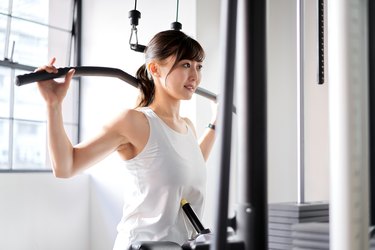

From improving posture to building stronger back muscles — specifically your lats — the lat pulldown is one of the best exercises all around. But one variation of this move you want to avoid is the behind-the-neck lat pulldown.
Here are all the reasons you should skip behind-the-neck lat pulldowns, and how to do the forward lat pulldown instead.
Video of the Day
The Risks of the Behind-the-Neck Lat Pulldown
The behind-the-neck lat pulldown involves you moving your neck forward to allow the bar to rest on your shoulders and on the base of your cervical spine. Because it puts you in a forward head posture while doing heavy pulling, it can cause tight neck muscles, as well as injury and even headaches, according to the National Academy of Sports Medicine (NASM).
"In a time when we are sitting on our phones looking down most of the day and exacerbating forward head posture or 'text neck," the majority of people should stay away from the behind-the-neck lat pulldown," says Joey Thurman, CPT, a certified personal trainer and corrective exercise specialist (CES).
"Besides placing your head extremely forward and flexing your cervical spine, it can also lead to injury of the rotator cuff (shoulder muscles that surround the ball portion of the ball-and-socket shoulder joint)."
The back-of-the-neck lat pulldown places more stress on your rotator cuff because the shoulder joint is forced to do horizontal abduction (raising your arms to the sides) and external rotation (bending your arm to 90 degrees and moving it outward).
These movements can be difficult for people who don't have adequate shoulder mobility and strength, says Leada Malek, PT, DPT, a licensed physical therapist and board-certified sports specialist.
Over time, doing this exercise in this compromising position can lead to shoulder pain and inflammation, making the muscles in your rotator cuffs more susceptible to injury, such as tendonitis, or worse, a tear, Thurman says.
"Rarely is an exercise ever a true 'no-no' without knowing the needs of an individual, especially if proper coaching is included. I'd say there are certainly better options, in terms of less strain on areas if you don't have adequate strength and mobility to achieve it with proper technique," Malek says.
The More Effective (and Safer!) Back Exercise
Fortunately, you can still gain the back-strengthening benefits of the behind-the-neck lat pulldown — which also works your biceps, deltoids (shoulders) and pectoralis minor (chest) — by doing the forward lat pulldown.
The forward lat pulldown, in which you pull the bar down in front of your face until it's slightly above or touching your upper chest, is a much safer back exercise because it removes the stress on your shoulder joint and neck.
"You can recruit the lats at a much higher degree, along with the pecs and biceps," Malek says. "You have these stronger muscles working for you in a position that is much easier to move in and out of for a joint that is very mobile with high needs of stability."
The forward lat pulldown not only protects your shoulder joint but also keeps your cervical spine in a more neutral position. This protects your neck from injuries and muscle strain.
For most people, the forward lat pulldown is a great exercise for strengthening and toning your back.
"People often want to do the fancy exercises that they see on social media, but in reality, basic movement patterns and lifts with good form and intent should be your priority," Thurman says. "Doing this with quality reps over quantity will ensure you are getting continuous gains in the gym."
How to Do the Forward Lat Pulldown
- Sit on the bench of the lat pulldown machine with your legs at 90-degree angles.
- Grab the bar with your palms forward (overhand grip) and your hands shoulder-width apart or slightly wider than shoulder-width.
- While holding the bar, brace your core and lean back slightly. Keep your spine in a straight line and make sure you aren’t arching your lower back.
- Pull the bar down toward your chest, stopping when it reaches your upper chest or just above your chest.
- Return to the starting position with your arms straight overhead.
- Focus on pulling down for 1 to 2 seconds and going back up for 2 to 3 seconds.
- Keep your motions slow and controlled.
Warning
“If you do have a shoulder injury or pain, reaching up and into this region without modifying the range of motion or being particular about technique can contribute to pain,” Malek says.
“I would also caution anyone with neck or nerve pain to ask a physical therapist prior to trying the forward lat pulldown. Extending your arm can stretch nerves and cause pain along your arm or neck.”
Tip
The overhand grip is the best way to work your lats, but to switch things up and work your muscles differently, the underhand grip (palms facing you) is also effective, according to the NASM.
"Drive your elbows down to the point where your upper arm is in line with your torso," Thurman says. "Bringing your elbows past your torso is fine, but the lats stop working at that point."